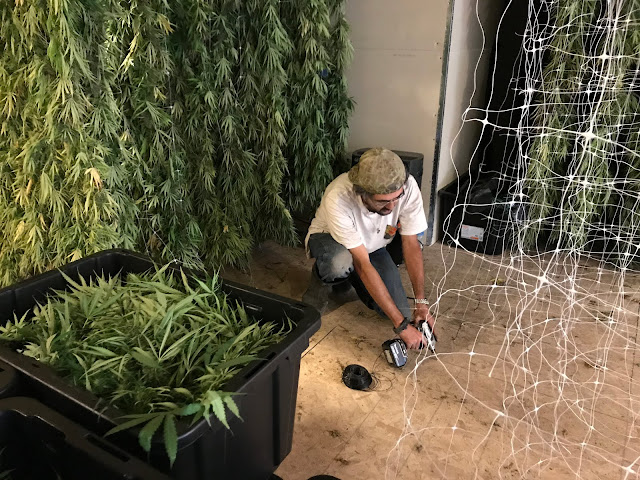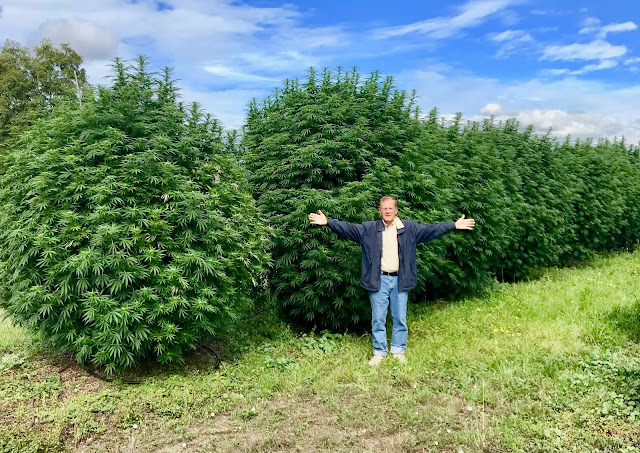
There are problems to overcome.
Finding labor to do harvest and dry it.
Expensive machinery.
A location and system to dry the crop.
Insects and mold.
Southern Oregon residents notice the smell. Some people think it smells like pine trees. Most people think it smells like skunk. The buds are sticky with resin that gives off the odor. The harvest is happening around us.
Almost all of what people see in the fields are hemp plants bred for CBD which is being made into medicines and food additives and is infused in athletic wear. Some people think CBD is a miracle drug. For some people it is a pain reliever. For others it aids sleep. Others say it reduces anxiety. There is some evidence it reduces epileptic seizures.
Trade magazines say the market is huge and every bit of the crop will be sold at prices that will make growers very, very happy.
Next: photos of drying rooms, buds, and harvest equipment.
Trade magazines say the market is huge and every bit of the crop will be sold at prices that will make growers very, very happy.
Next: photos of drying rooms, buds, and harvest equipment.
 |
| CBD top branch "candle" of buds. |
The CBD plant and the THC plant are two varieties of the same plant, analogous to the way that toy poodles and german shepherds are both dogs, but bred for different qualities. In cannabis, one variety is bred for maximum THC, the molecule that gets people high. The CBD plant has almost zero THC.
The THC plants are usually grown to be large. The CBD plants are grown in fields and are smaller. Outdoors most varieties of the plant go into flower in early August triggered when hours of sun have reduced from the longer days of June. Now, sixty days later, the crop is ready to harvest.
Lots can go wrong when grown at industrial scale. The highest value for the browser comes from perfect CBD-laden buds that were organically grown, harvested by hand, and then hand trimmed--a process that requires crews doing tedious work, bending, clipping off branches of buds, putting them into plastic totes, and then hanging the foot long bud branches to dry, then clipping off the bits of leaves and stems.
Mold spores might be on the plants and the mold incubates during the drying process, which takes about a week even in dark rooms with de-humidifiers sucking out the moisture. Mold makes the crop unsellable.
A single branch from a CBD plant:
Dense rows of branches drying. Fans circulate the air, dehumidifiers dry the air.
Plants grown for THC are typically allowed to grow bigger. I am pictured here visiting a THC grow site. The regulations, controls, and monitoring involved with a site that grows THC are burdensome for the growers. The State of Oregon tracks the THC product from the beginning through final distribution. The dense bushy plant has been draped with white plastic netting obscured by the foliage to support the weight of the branches. Otherwise the heavy buds would case the branches to sag and break.
 |
| Preparing the drying racks. Tote box of CBD branches to be hung. |
 |
| Drying nets, hanging branches, and tote box ready to hang. |
A single branch from a CBD plant:
Dense rows of branches drying. Fans circulate the air, dehumidifiers dry the air.

Plants grown for THC are typically allowed to grow bigger. I am pictured here visiting a THC grow site. The regulations, controls, and monitoring involved with a site that grows THC are burdensome for the growers. The State of Oregon tracks the THC product from the beginning through final distribution. The dense bushy plant has been draped with white plastic netting obscured by the foliage to support the weight of the branches. Otherwise the heavy buds would case the branches to sag and break.
 |
| Visiting a THC grow site |
Large grow sites of hemp cannot get the crop harvested through hand labor, and they are using large threshing and baling machines like the one pictured here on its way to a 600 acre grow site at the base of Lower Table Rock.
 |
| Thresher and bailer |
A new variety of the plant has been developed--called auto flower--which goes into flower on its own very quickly without the sun trigger. Gardening expert and advocate Jeff Lowenfels has written a book on the plant and how home gardeners can easily grow this small container-friendly plant, and the short season accommodates colder climates. He likens it to growing tomatoes.


1 comment:
Informative, however I now have a craving for Pringles.
Post a Comment